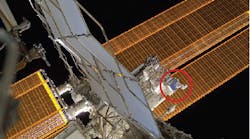Opportunities to perform research and technology demonstrations on the International Space Station are now being offered to academia, industry, and government agencies. Using the newly installed Space Communications and Navigation (SCaN) testbed, researchers can develop new software according to the Space Telecommunications Radio Standard (STRS) architecture for radios—and, in the process, reconfigure how radios communicate in space.
The SCaN Testbed is a communications, navigation, and networking demonstration platform based on the STRS (see figure). The experimental platform, which began its initial checkout activities on the space station on August 13, will operate for at least three years. Participating developers will provide software components to the STRS repository while enabling future hardware platforms to use common, reusable software modules.
In doing so, those experimenters will gain the opportunity to create the latest communications, navigation, and networking technologies both in laboratory and space environments. These new concepts will then be explored for future missions. The SCaN Testbed Cooperative Agreement Notice details the call for proposals using the orbiting laboratory’s SCaN Testbed research capabilities. NASA expects initial demonstrations to take place by late 2013 or early 2014.
